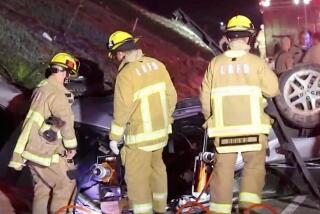‘Moment of truth’: And now, 45 years later, the line still forms to the right . . . of way
My former colleague John Cornell writes to express his disappointment that there was no mention in our paper of a recent milestone--the 45th anniversary of the Pasadena Freeway.
Well, after 40, one tends to think of anniversaries only in multiples of 10.
But the Pasadena Freeway was special. It was the first freeway in the West--third in the nation--and it remains today much as it was on the day it was opened to traffic--Dec. 30, 1940--a year before Pearl Harbor.
Cornell has a special feeling for the freeway because he was the first motorist to drive it--from downtown Los Angeles to Pasadena--on assignment for West-ways magazine.
Cornell was euphoric:
“From the relatively narrow Figueroa tunnels you suddenly find yourself launched like a speedboat in a calm, spacious divided channel. Channel is the word, too, for it’s in the arroyo, below the level of traffic-tormented streets.
“No brazen pedestrians nor kids riding bikes with their arms folded! No cross streets with too-bold or too-timid drivers jutting their radiators into your path. And no wonder I made it from Elysian Park to Glenarm Street in Pasadena in 10 minutes without edging over a conservative 45 miles an hour. . . . “
Cornell also took note of the hazards: the sudden off-ramps; and, even worse, the sudden on-ramps, which still exist today. There were no acceleration or deceleration paths, to use the language of the highway engineers. To get on, you looped down an access road to a stop sign, and stood there waiting for an interval in the traffic that raced by in the right-hand lane. Then, pumping adrenaline, you hit the gas and said, “Go! . . . Go! . . . Go!” without daring to look back for anything that might be gaining on you.
That hasn’t changed. Every time you get onto a busy Pasadena Freeway you experience the bullfighter’s “moment of truth.”
I have a paper written by A. D. Griffin, who was design engineer for the freeway, explaining this phenomenon. The freeway was built in the Arroyo Seco (dry creek) that comes down from the mountains to the Los Angeles River. (It was originally called the Arroyo Seco Parkway--a name that seems to have been forgotten.) Because the creek sometimes became a rushing current in rainy season, it was necessary to build a flood control system before the freeway could be built. This cost almost two-thirds as much as the freeway.
The freeway ran between the concrete flood control channel and the Union Pacific right of way, thus limiting its width to four lanes, plus two shoulders. Late estimates of probable traffic caused a last-minute change of plans: the freeway would have to be six lanes, with no shoulders.
Not only did it have no shoulders, it had numerous big curves that a driver in the right lane could not see around. If he came up on a stalled car at 55 m.p.h. it was hit the brakes and pray.
It is the same today, except for several “refuge bays” that have been squeezed in on the outside lanes. If you’re lucky enough to be able to coast into one of these bays when your car goes dead, you’re OK.
Even with all these faults, it was a great achievement. It was the start of the Freeway Age for Los Angeles. It made us forever an automobile metropolis, spelled the end of rapid transit, and opened us up to almost limitless urban sprawl.
Gov. Culbert L. Olson himself presided over the ribbon cutting, winding up to some of his finest oratory. He noted that it had taken 45 years to bring the freeway from dream to reality, and praised its engineers for their boldness.
“I say bold because they were just that. They dealt boldly and realistically and effectively with a traffic problem that had become almost terrifying. . . . Now that we have it, and it all looks so rather simple, so obviously necessary, so wholly practical, there will be some who will ask, ‘What is there so wonderful, or so bold about it?’
“Oh, yes--but it takes courage to do a thing the first time, no matter how simple and obvious it may appear after it is done. And this, fellow citizens, is the First Freeway in the West .” (Despite such eloquence, Olson lost the next election to Earl Warren.)
That was only the six-mile portion of the freeway from Avenue 22 to Pasadena. The 2.2-mile portion between Avenue 22 and the four-level structure downtown was completed three years later. Our orbits have been designed by freeways ever since.
Whatever its shortcomings, which perhaps will never be corrected until we have exhausted our demand for new freeways and the money is forthcoming, the Pasadena Freeway is in some ways still the most beautiful to travel--especially going north and east.
It passes through a chain of lovely small parks, shaded by sycamores and eucalyptus, passes the castle-like Southwest Museum on Mt. Washington, and winds out toward Pasadena over a series of engaging if dangerous curves, here and there exposing the denim blue or snow-capped San Gabriel Mountains.
In their wisdom, the designers insisted on a ban on trucks. The ban still holds, and the absence of trucks goes a long way to make up for the flaws.
As a resident of the east slope of Mt. Washington I virtually live on the Pasadena Freeway. For 35 years it has taken me downtown to work and out to Pasadena for my shopping and pleasure.
But hardly a day goes by that I don’t feel like a bullfighter.
More to Read
Sign up for Essential California
The most important California stories and recommendations in your inbox every morning.
You may occasionally receive promotional content from the Los Angeles Times.









